Abstract
In this article, the author examines certain physical, chemical and biological characteristics of water-bodies which make them suitable or unsuitable as habitats for planorbid snails acting as vectors of bilharziasis. The principal conditioning factors appear to be: amount of food available; extent of the growth of aquatic weeds; oxygen content of the water; amount of sunlight able to penetrate the water; strength of the current; nature of the substratum; ionic composition of the water; and presence or absence of parasites and predators. Several of these factors are interdependent. Although there are differences between the various species in their habitat requirements, their ranges of tolerance were found to overlap greatly. The optimum conditions are similar for all species, but extremes are tolerated better by some species than by others. Theoretically, extremes of certain factors should be capable of eliminating snails from a body of water; in practice such extremes rarely occur, and the absence of vectors must be attributed to the combined effect of several factors. Although certain parasites and predators exterminate vectors in the laboratory, the author considers it unlikely that they would do so in nature, as under laboratory conditions the biological balance is disturbed to the disadvantage of the snail. The data available are still too scanty for an exact assessment to be made of the importance of individual environmental factors in controlling the size of vector populations; but this review of present knowledge indicates the lines along which further investigation can be most profitably pursued.
Full text
PDF
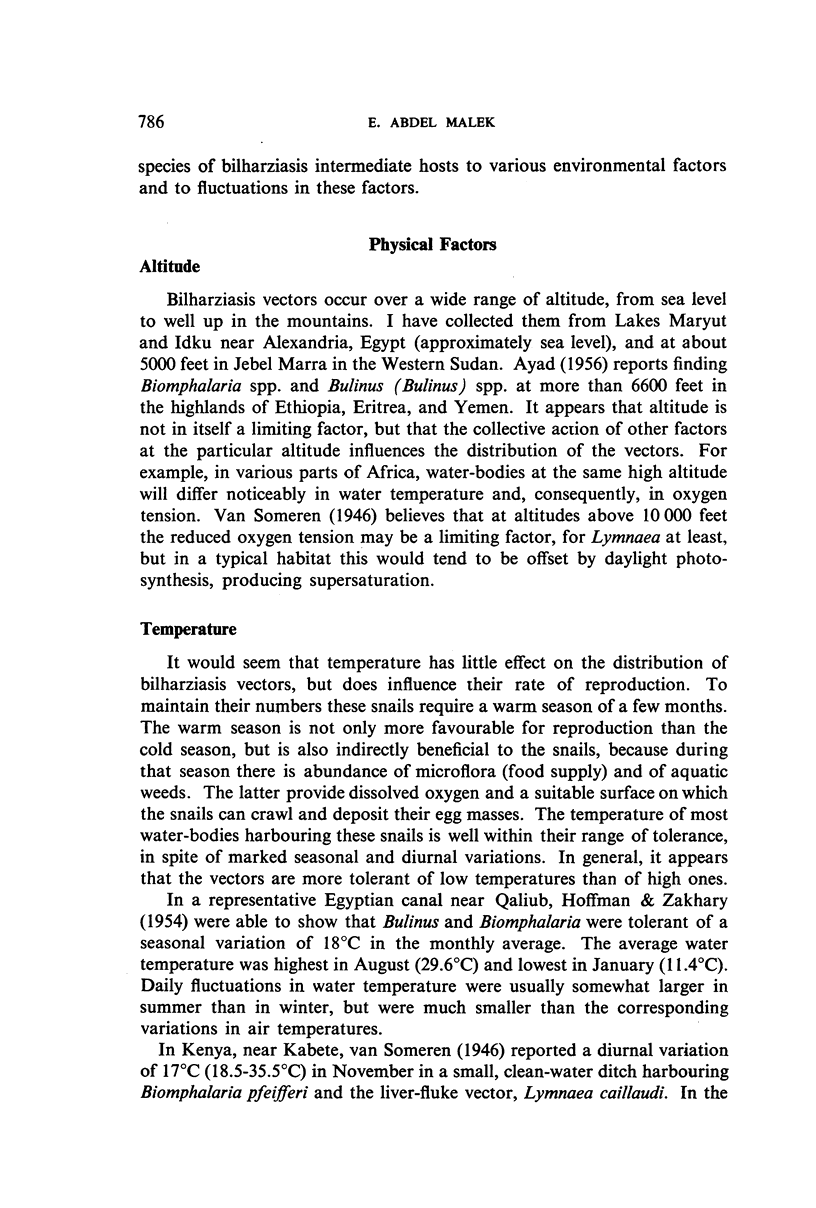
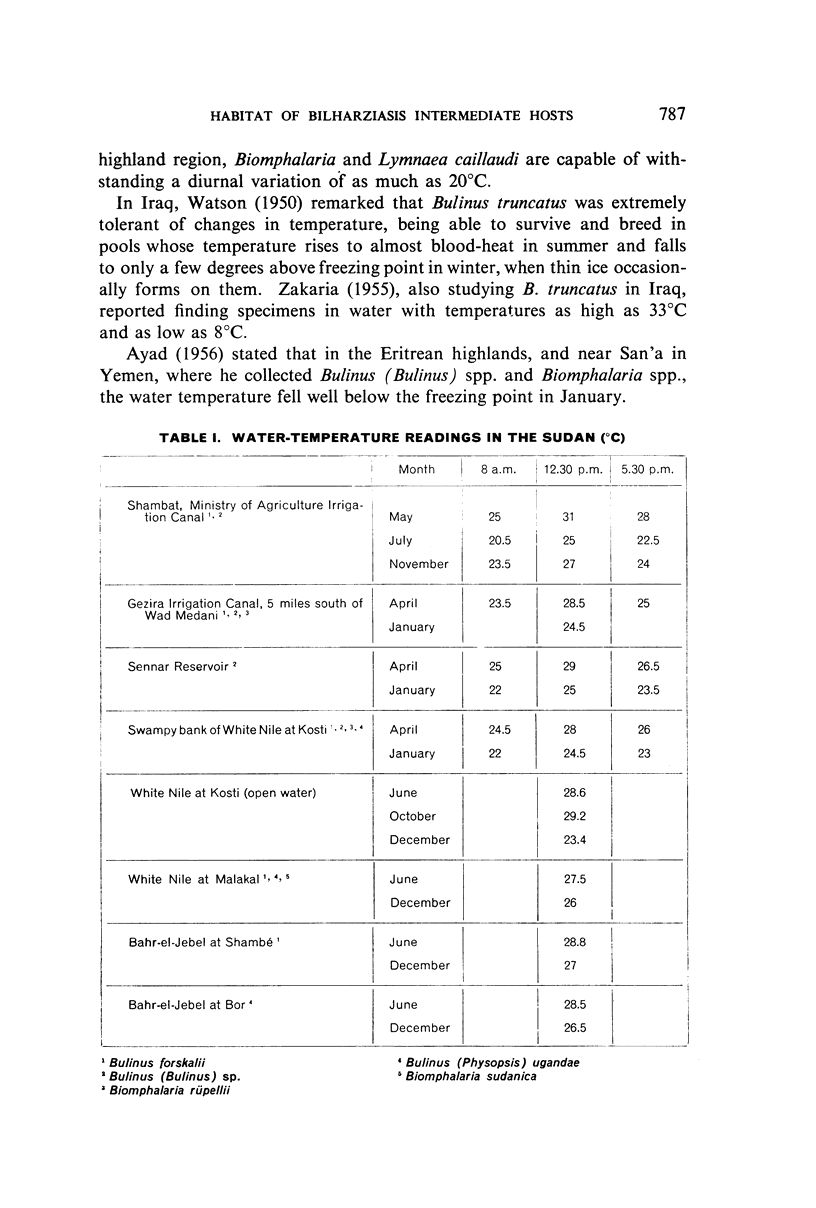
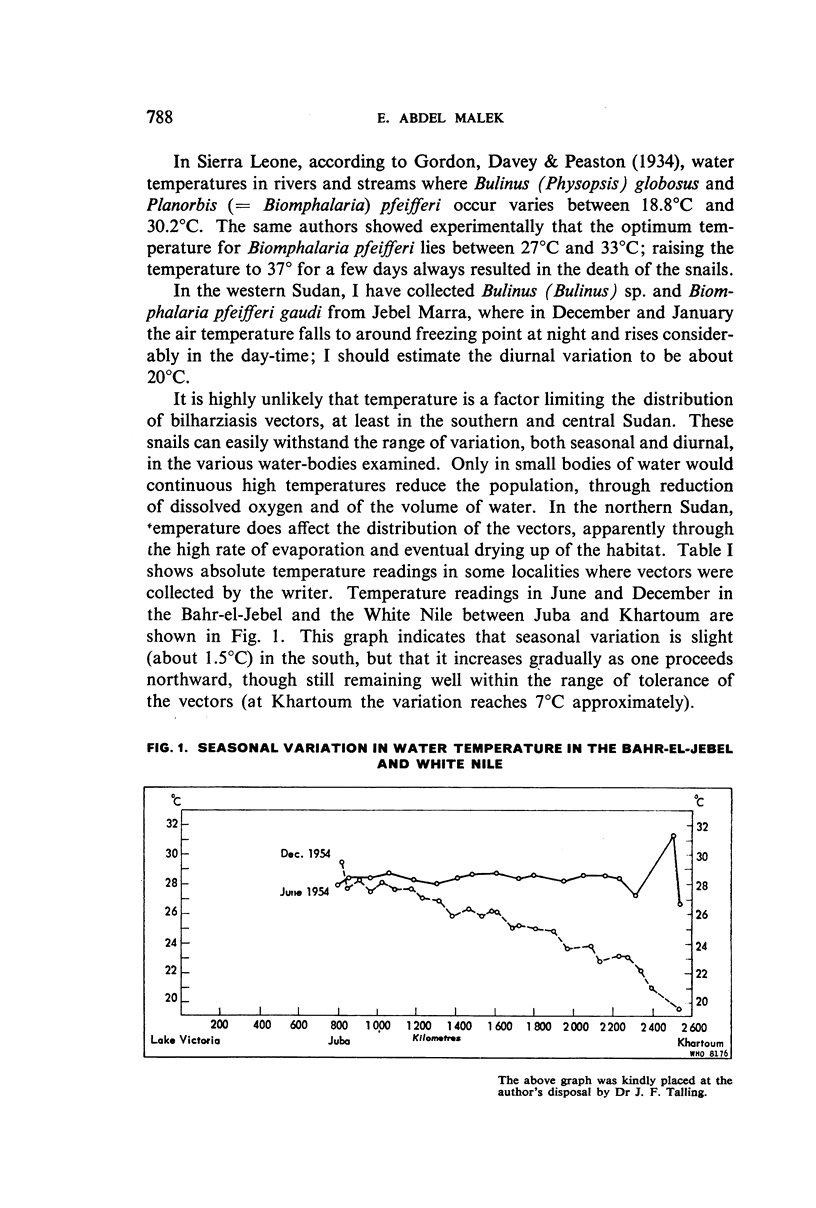
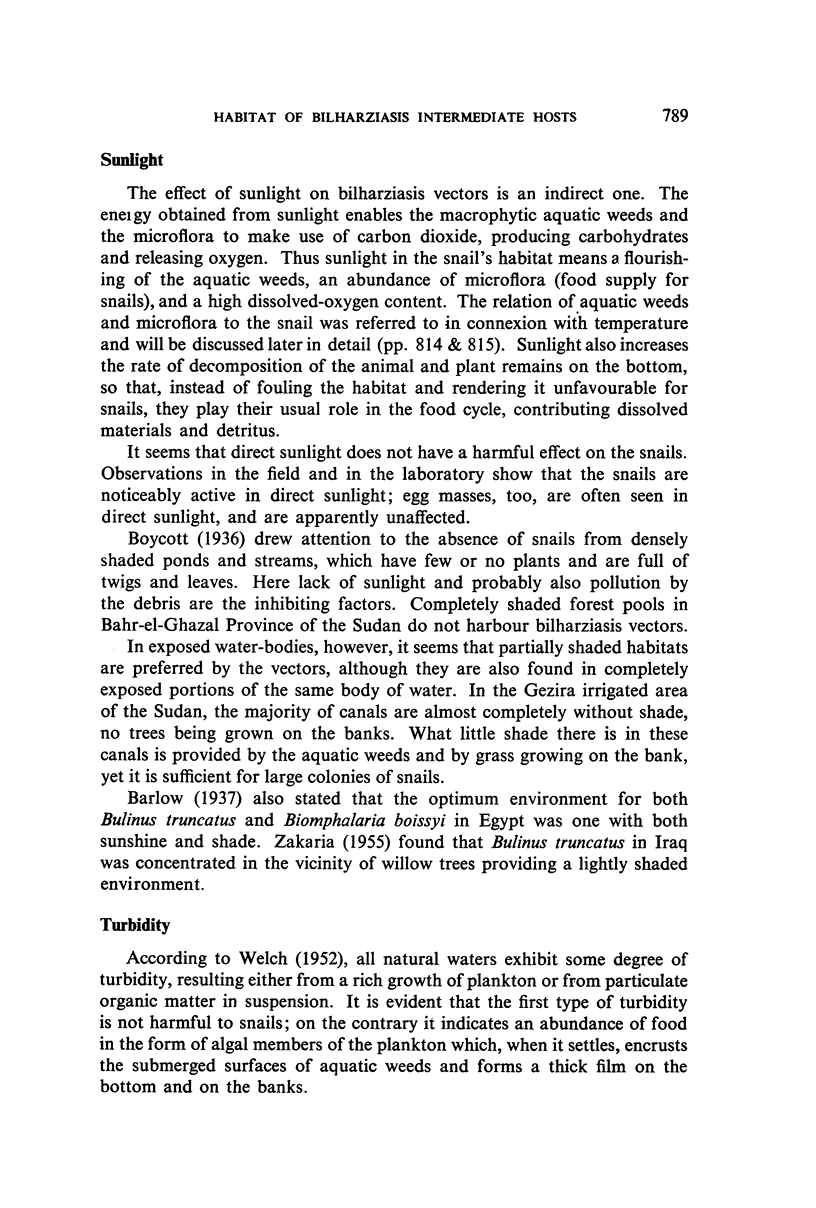
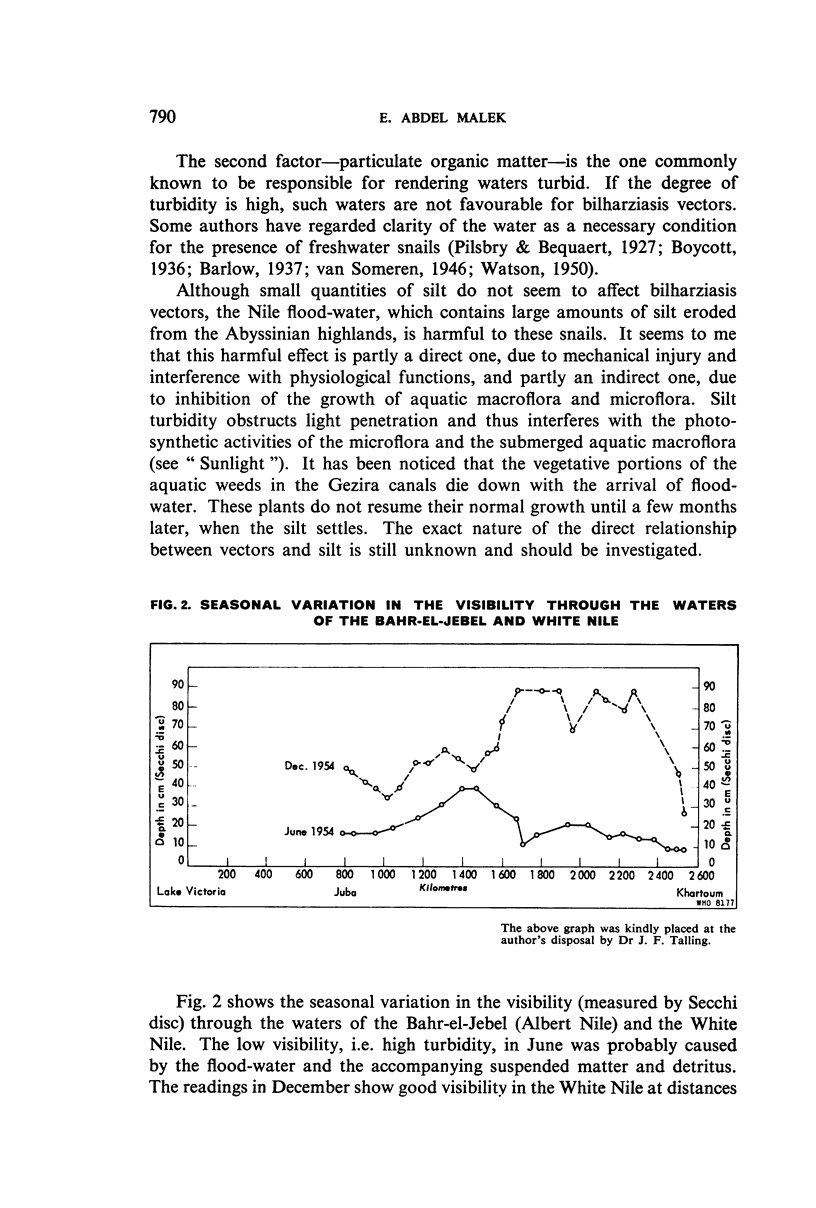
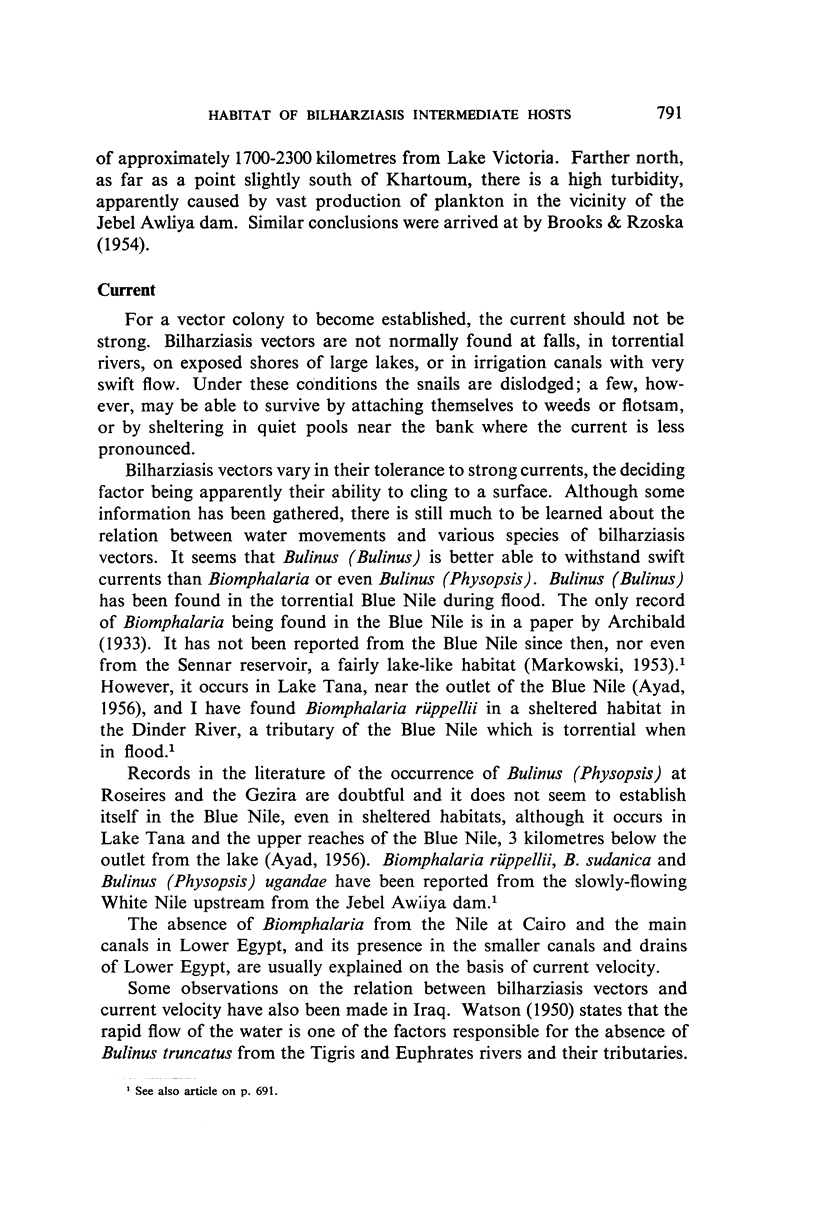
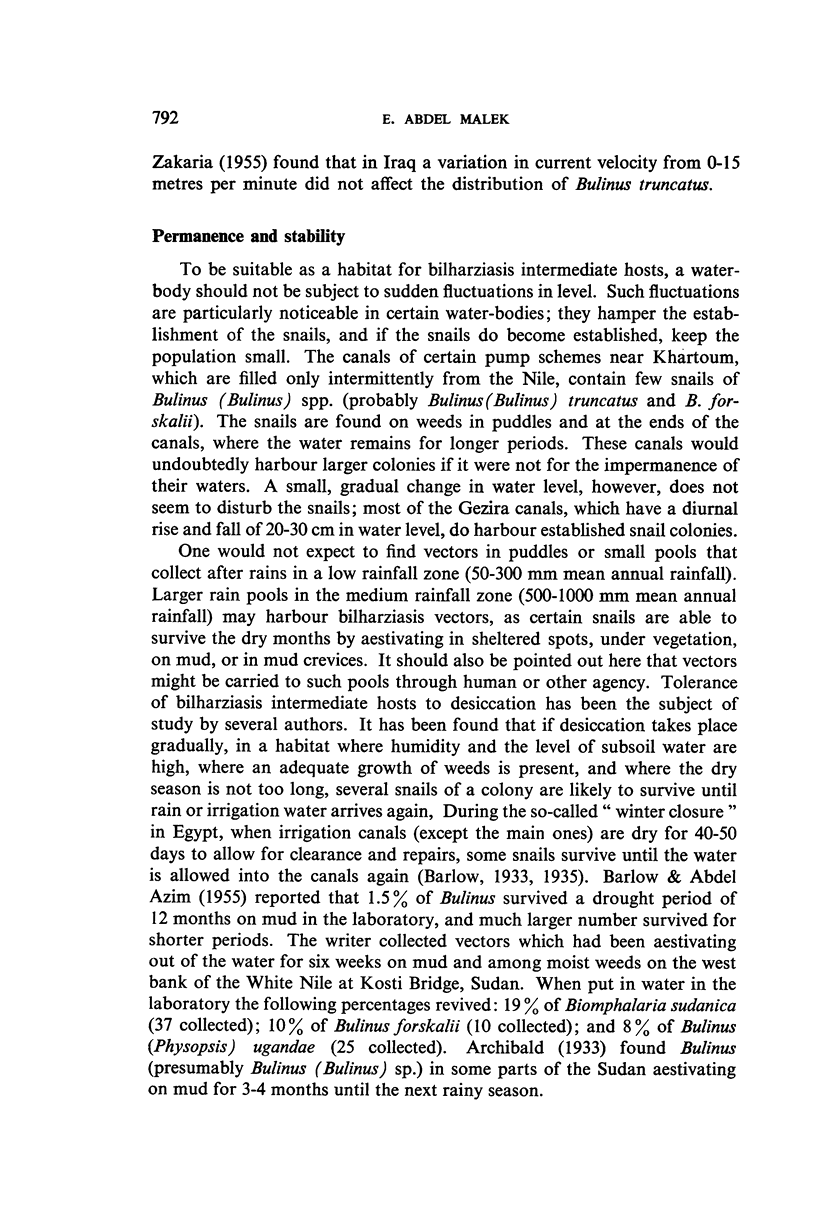

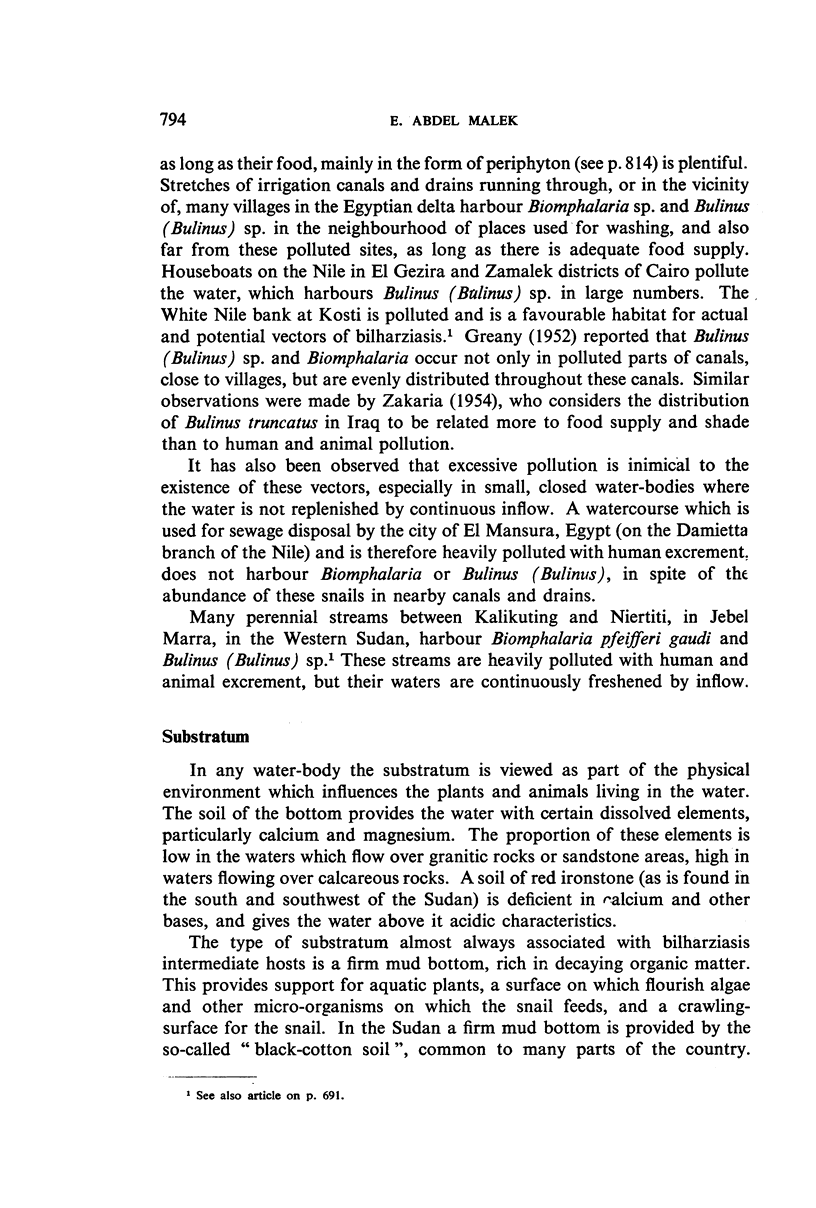
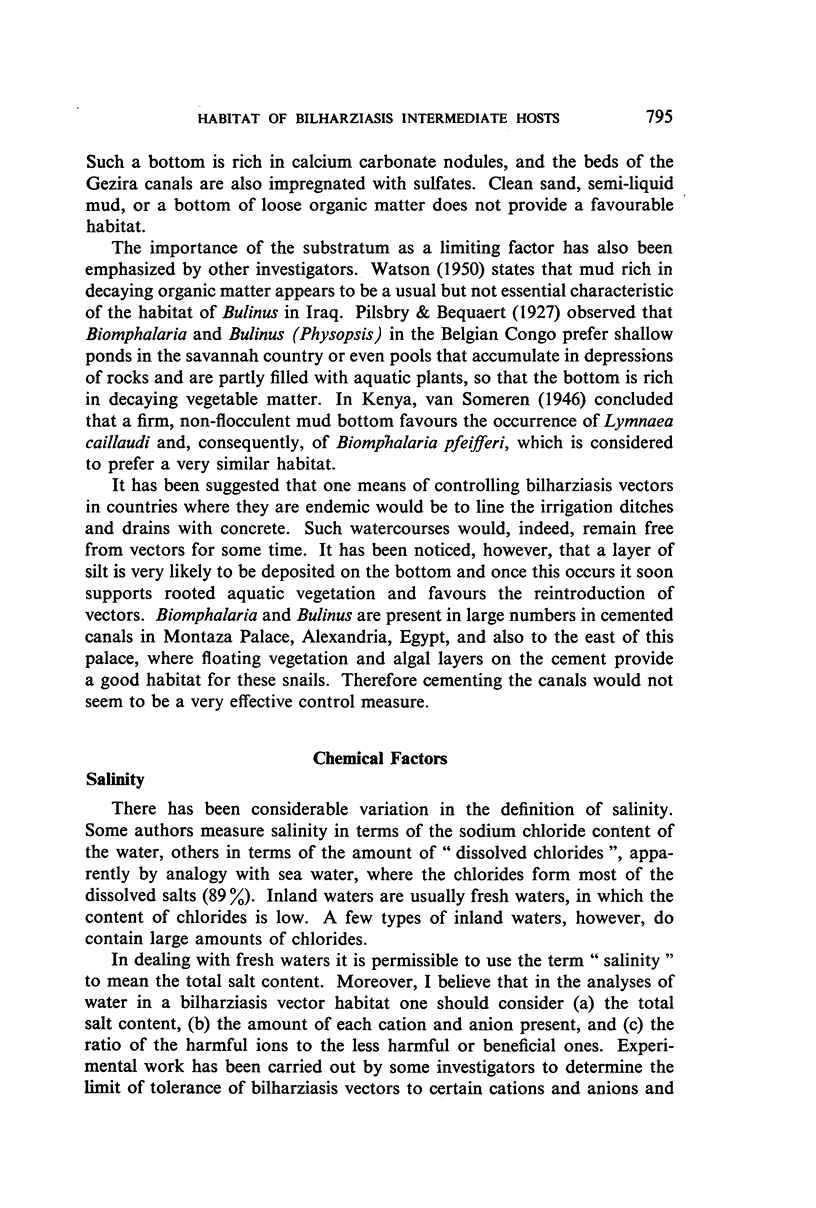
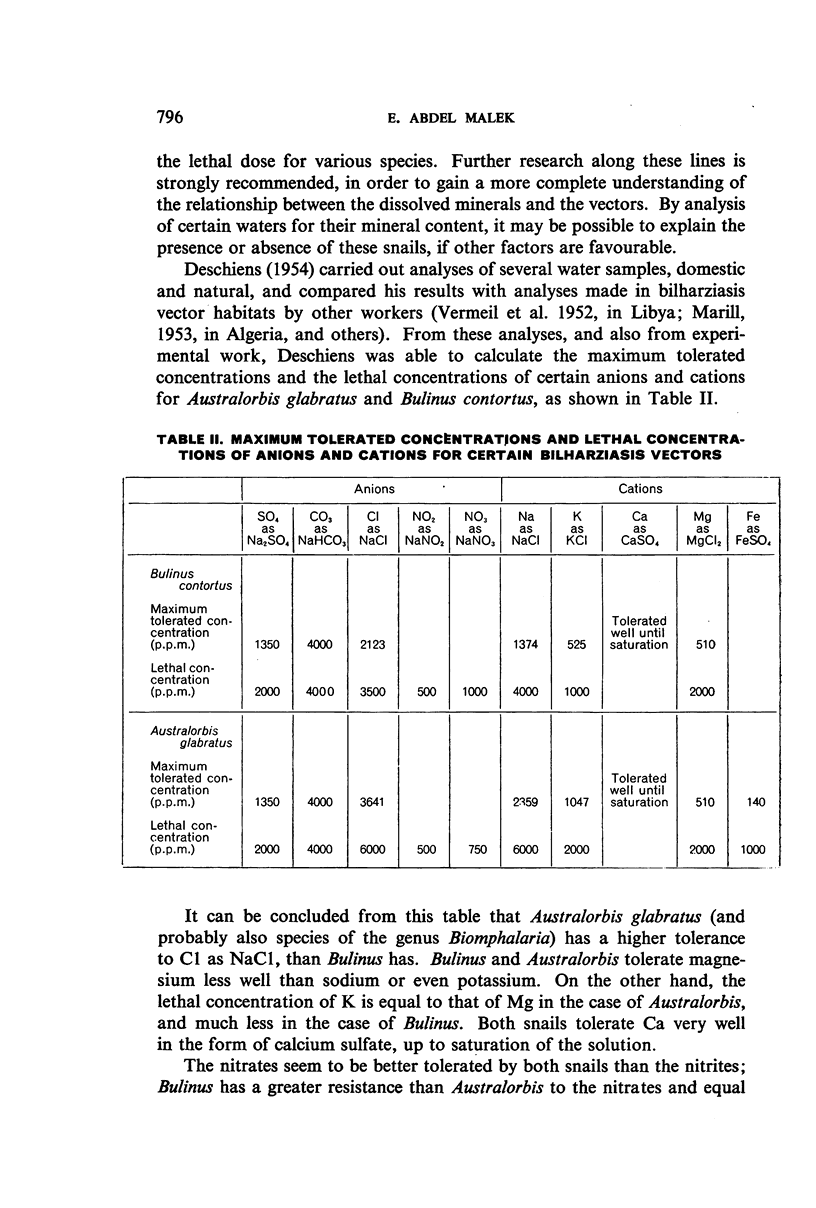
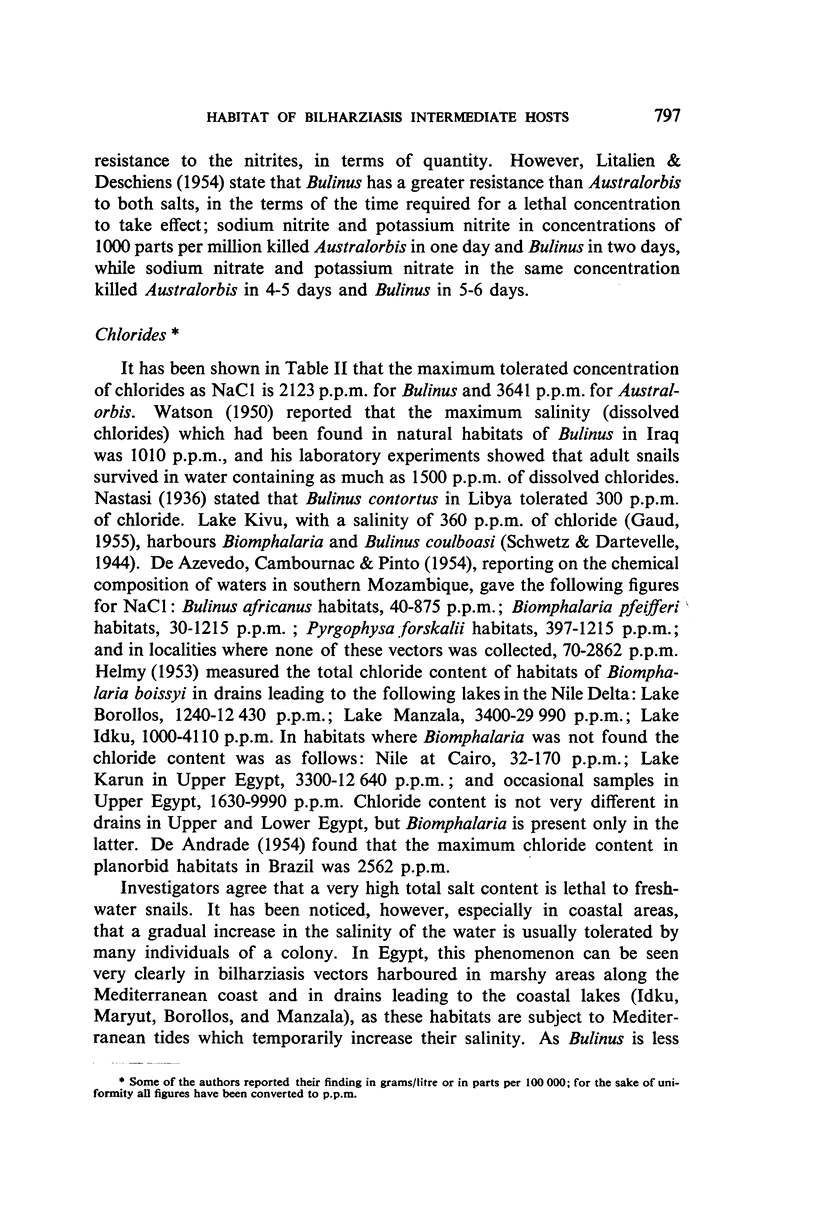
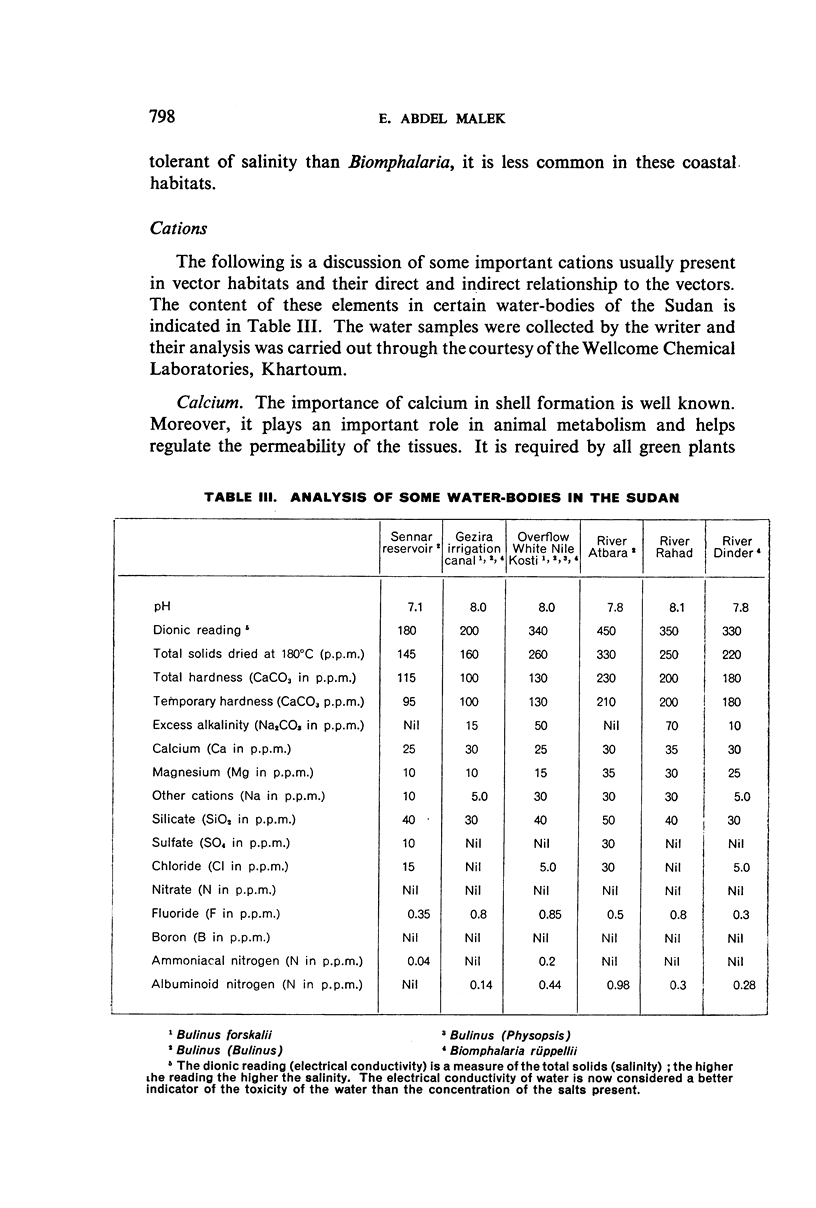
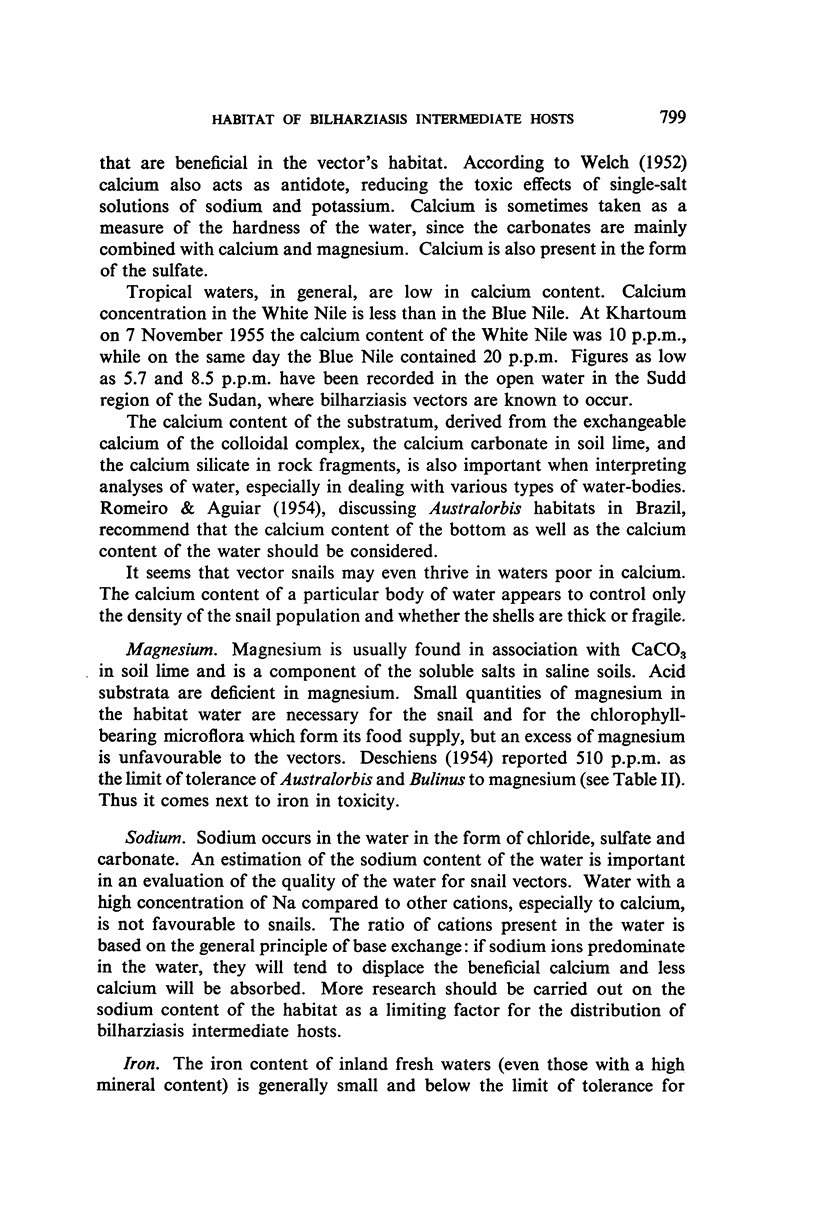
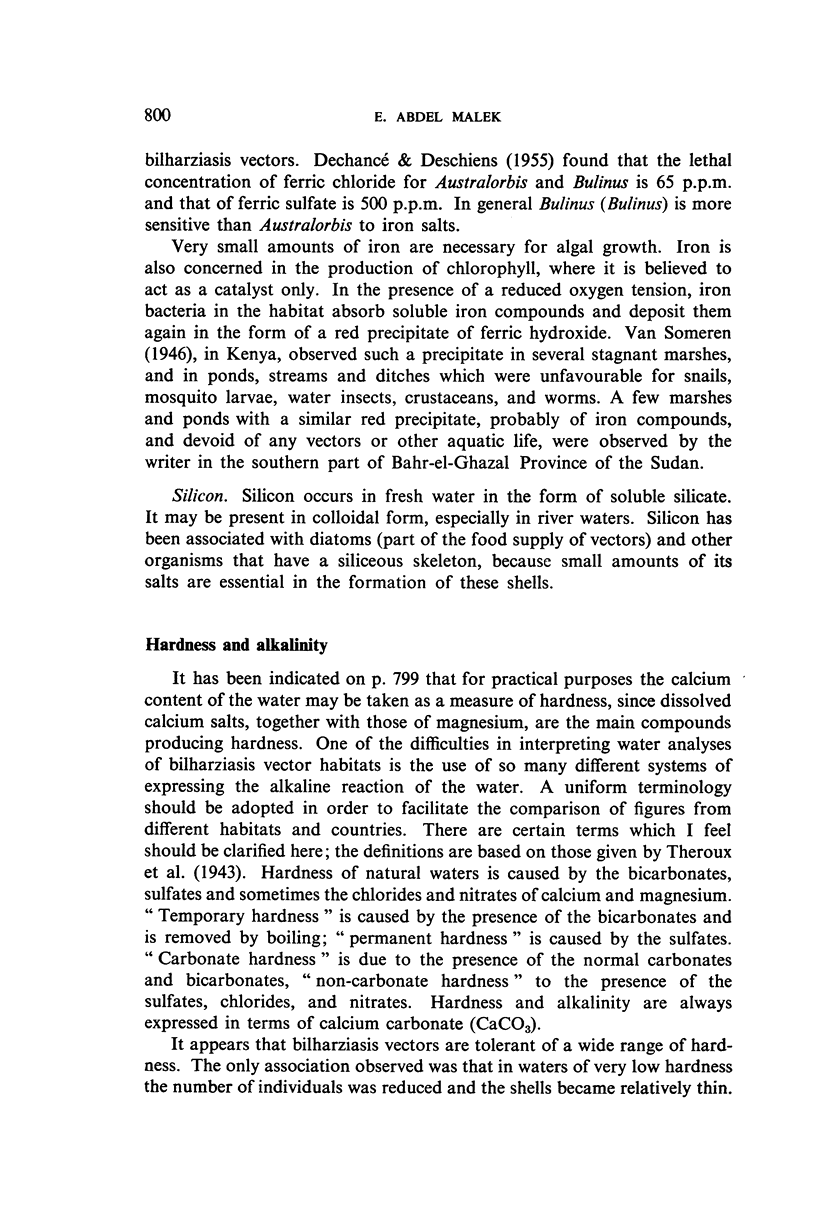

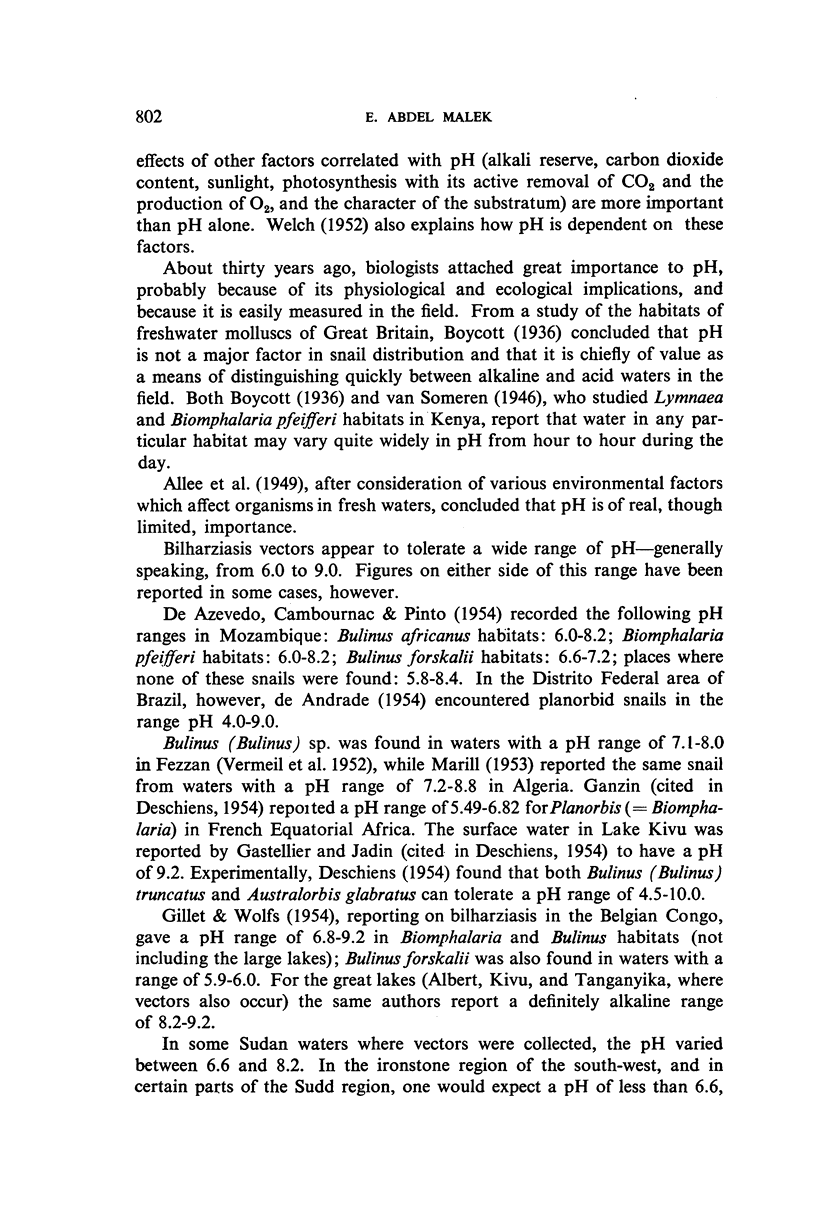
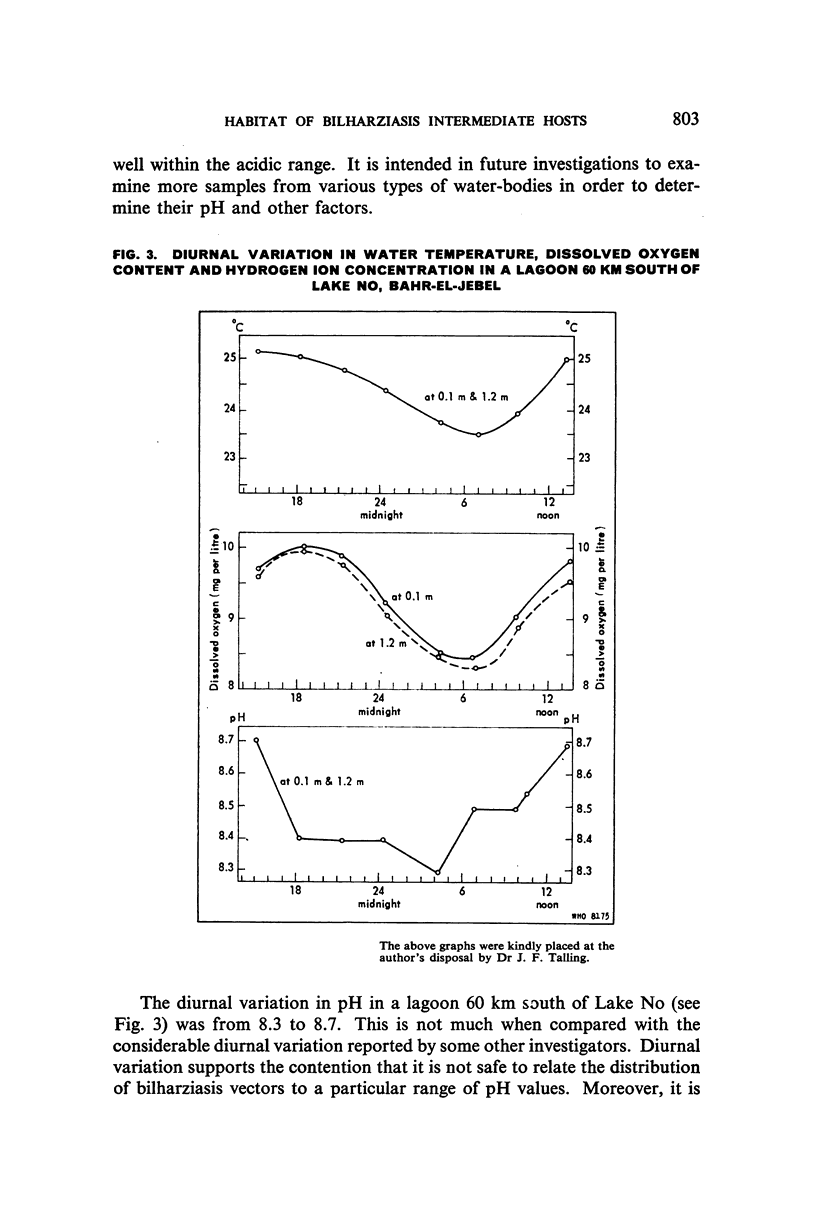
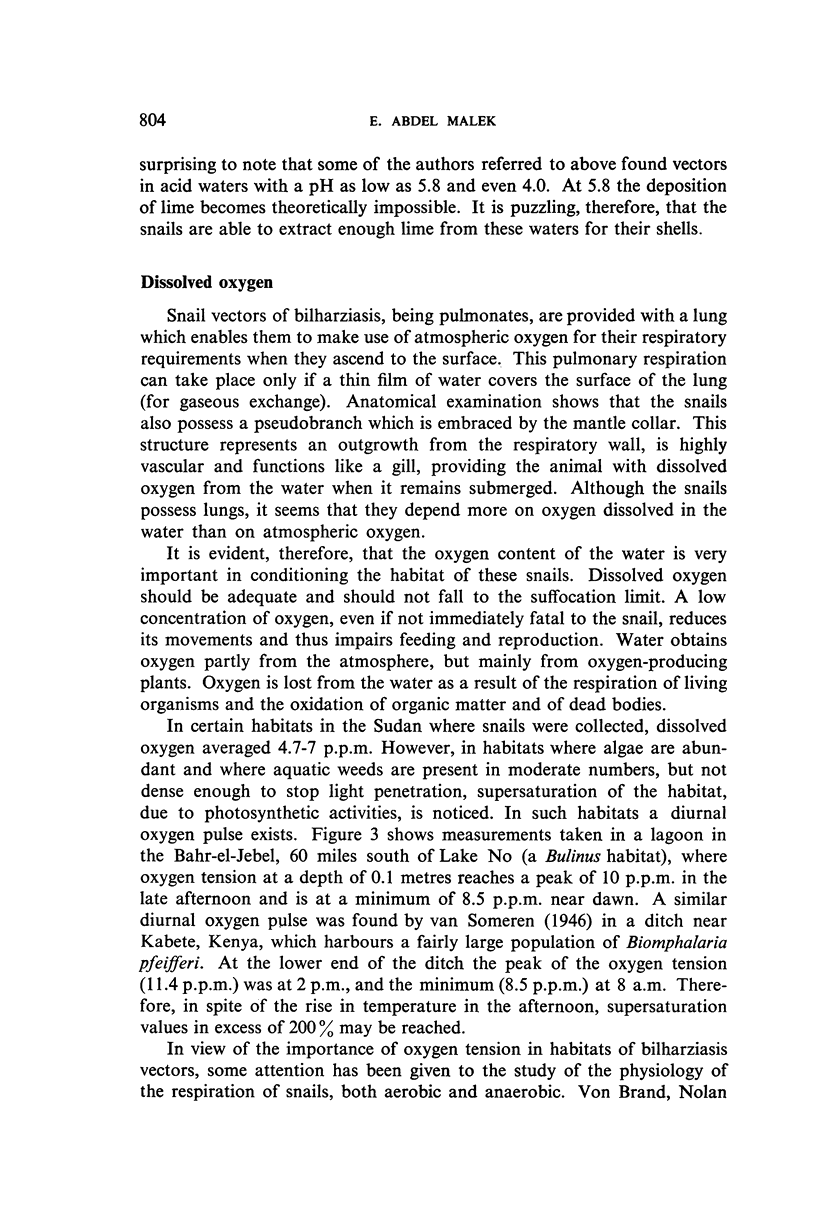
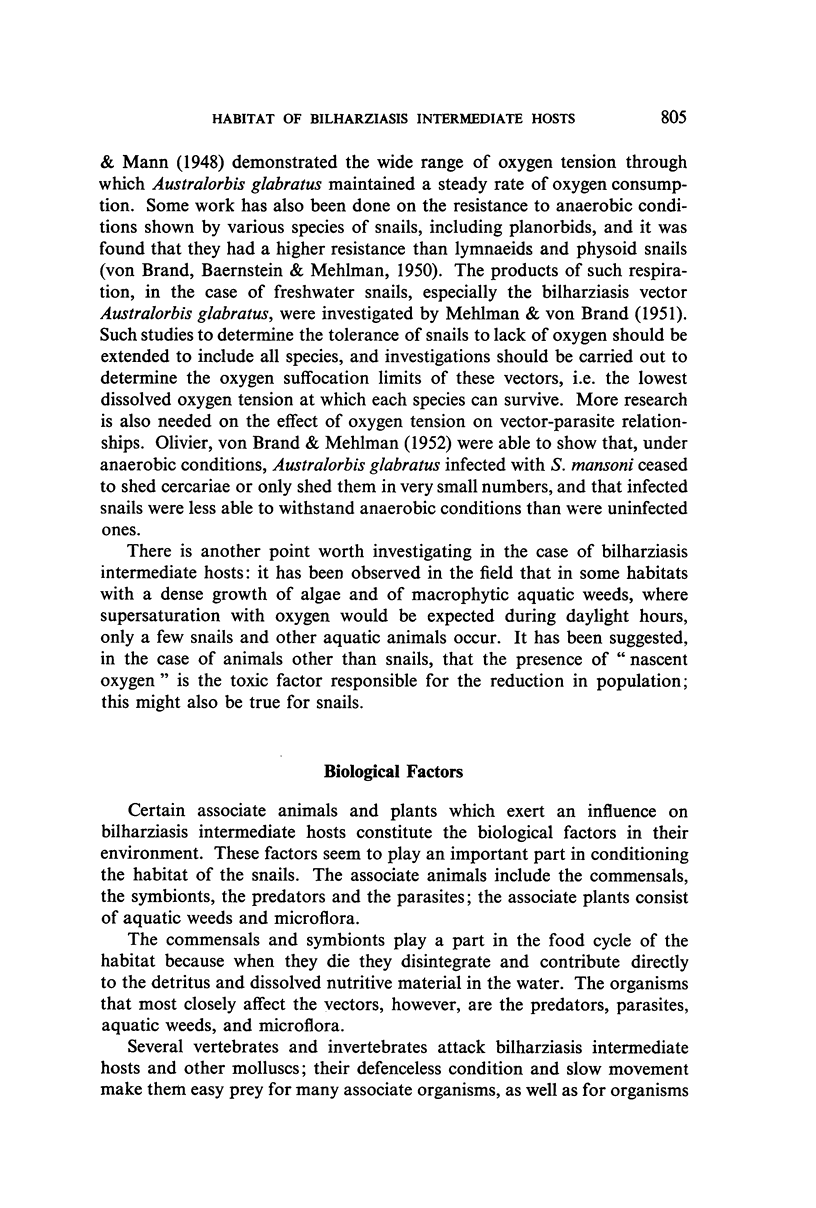
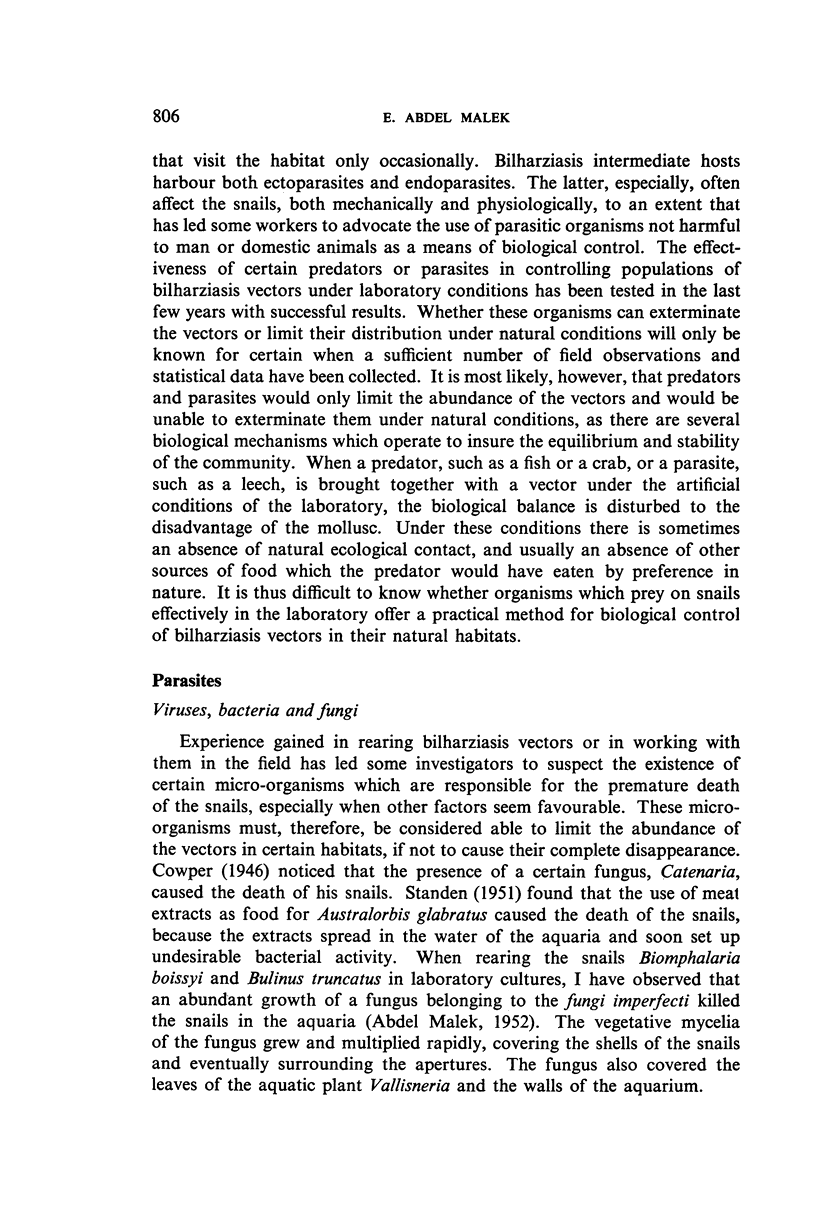
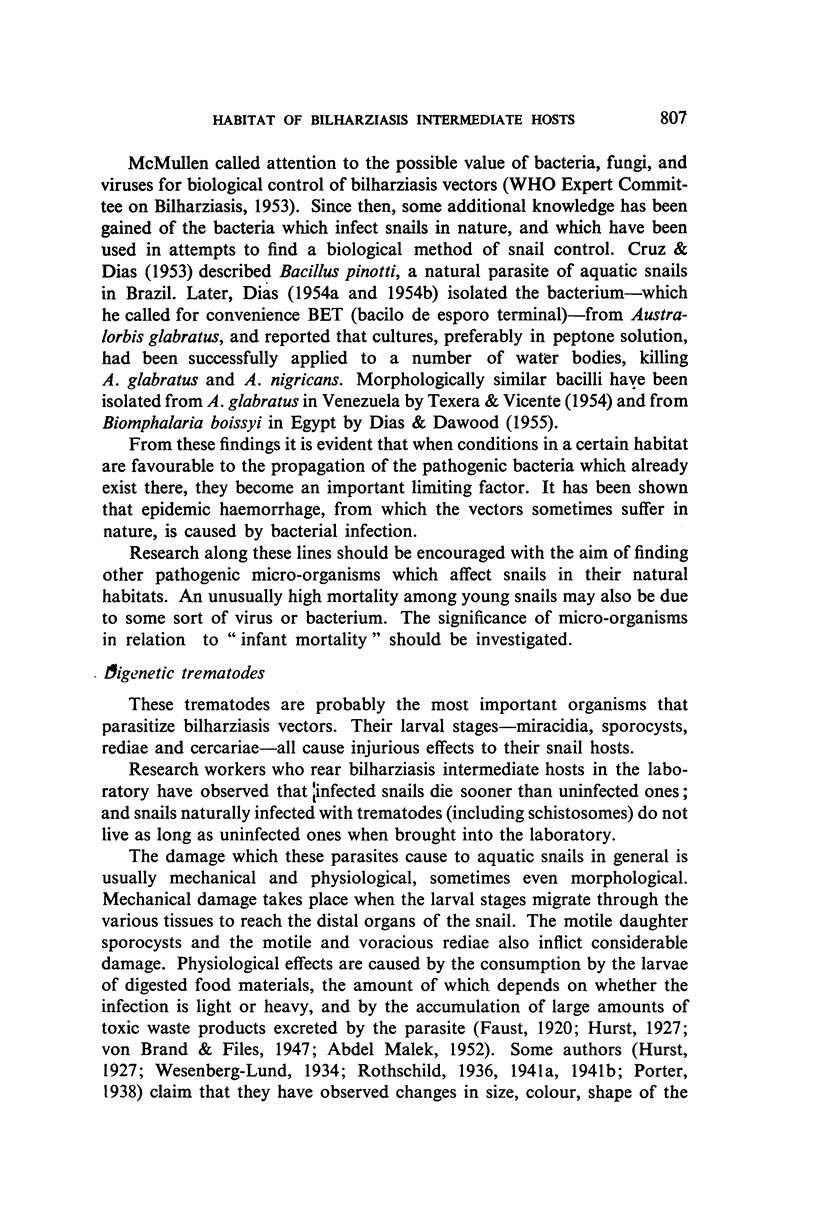
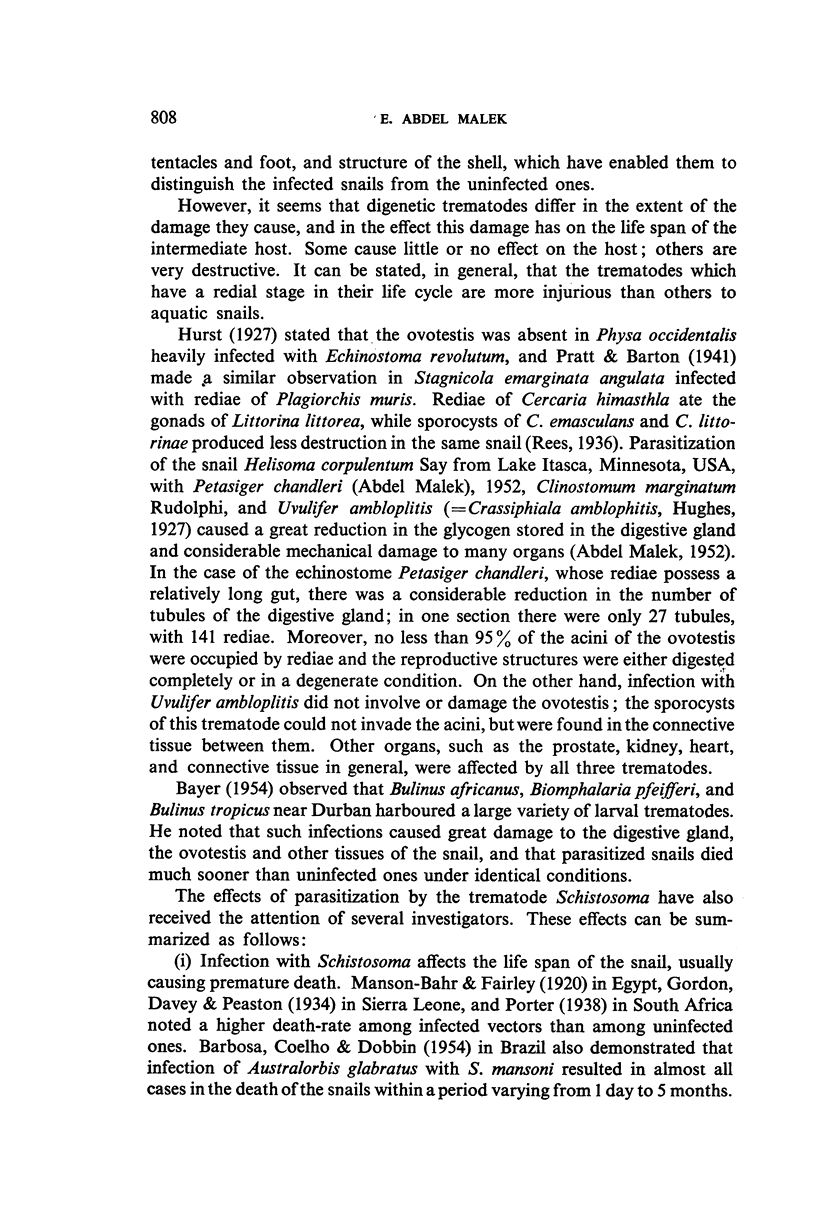
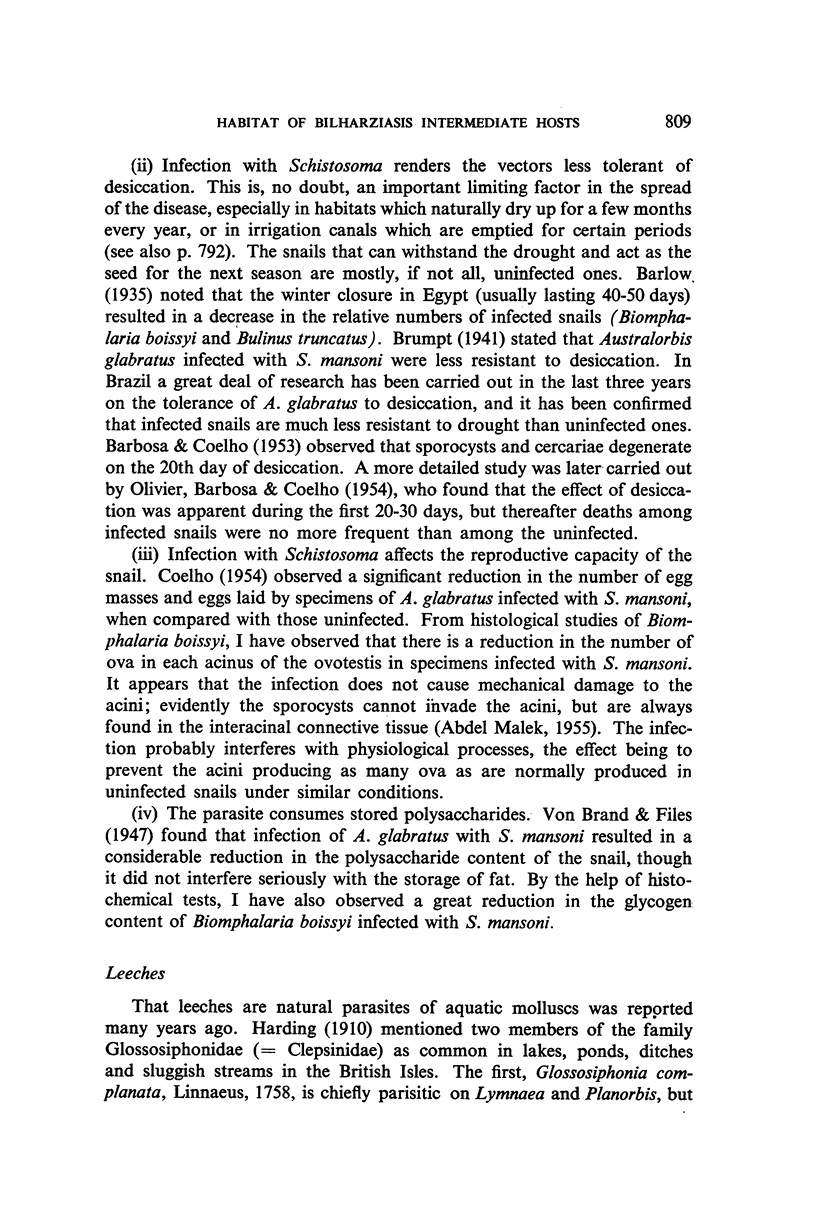
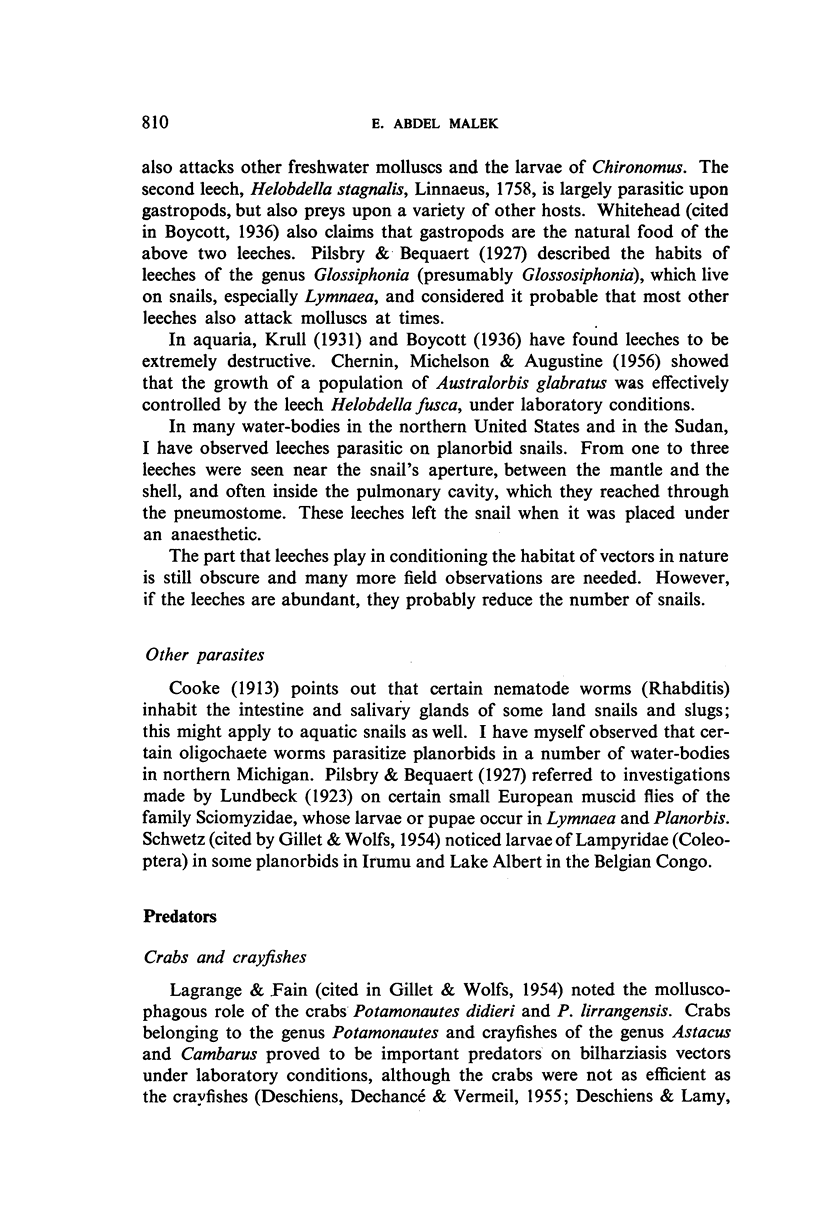
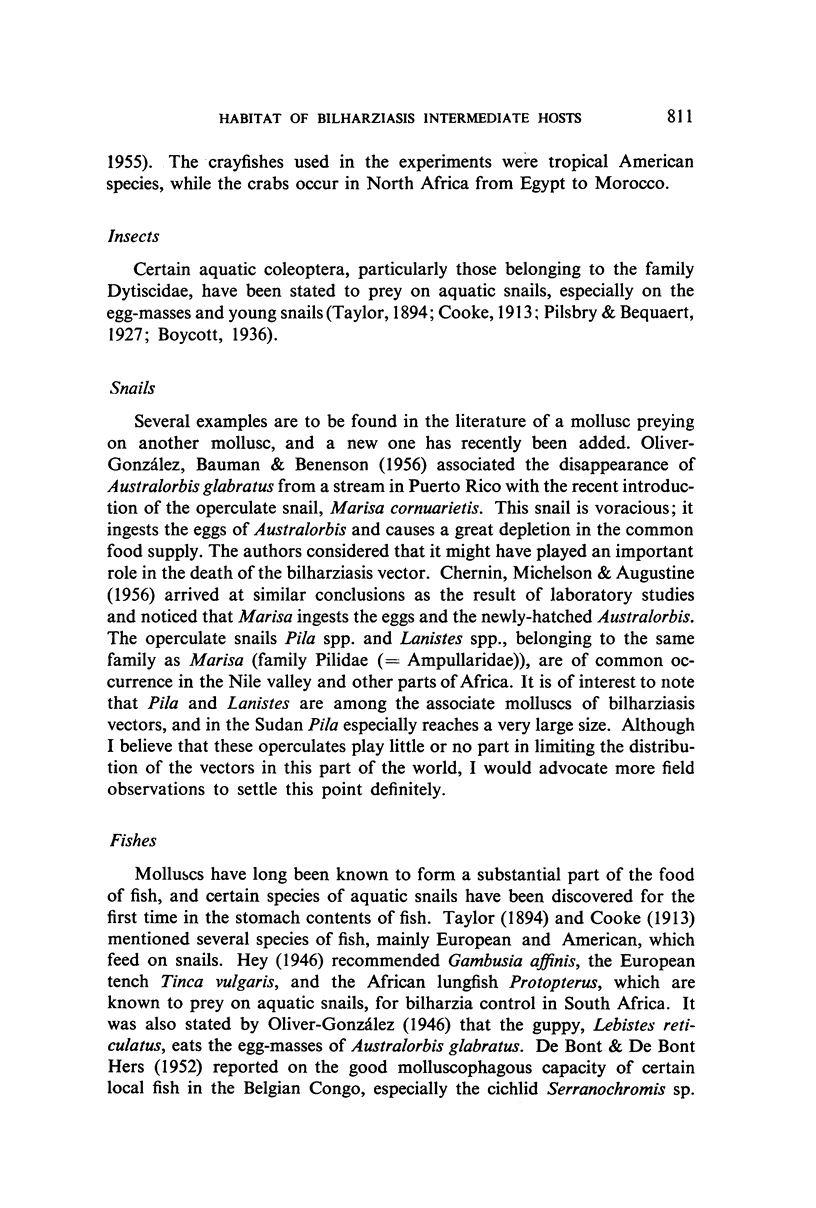
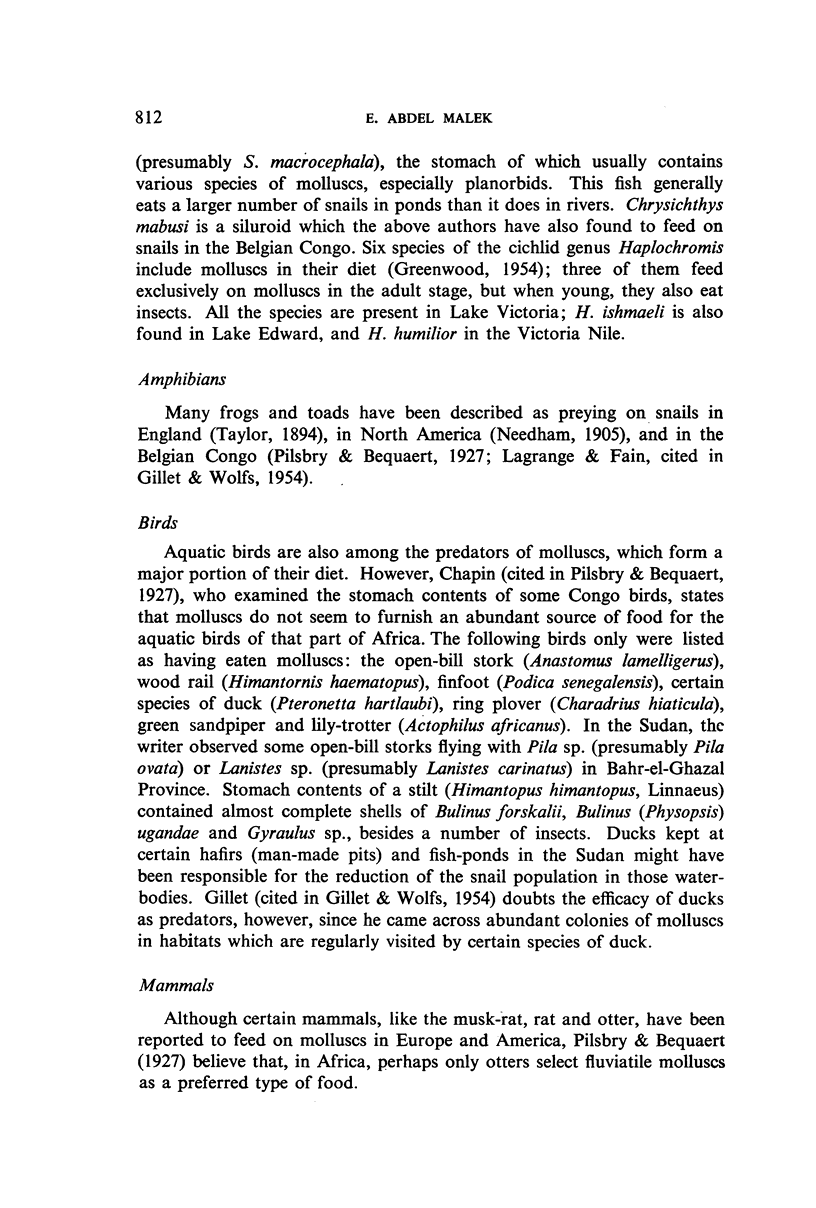
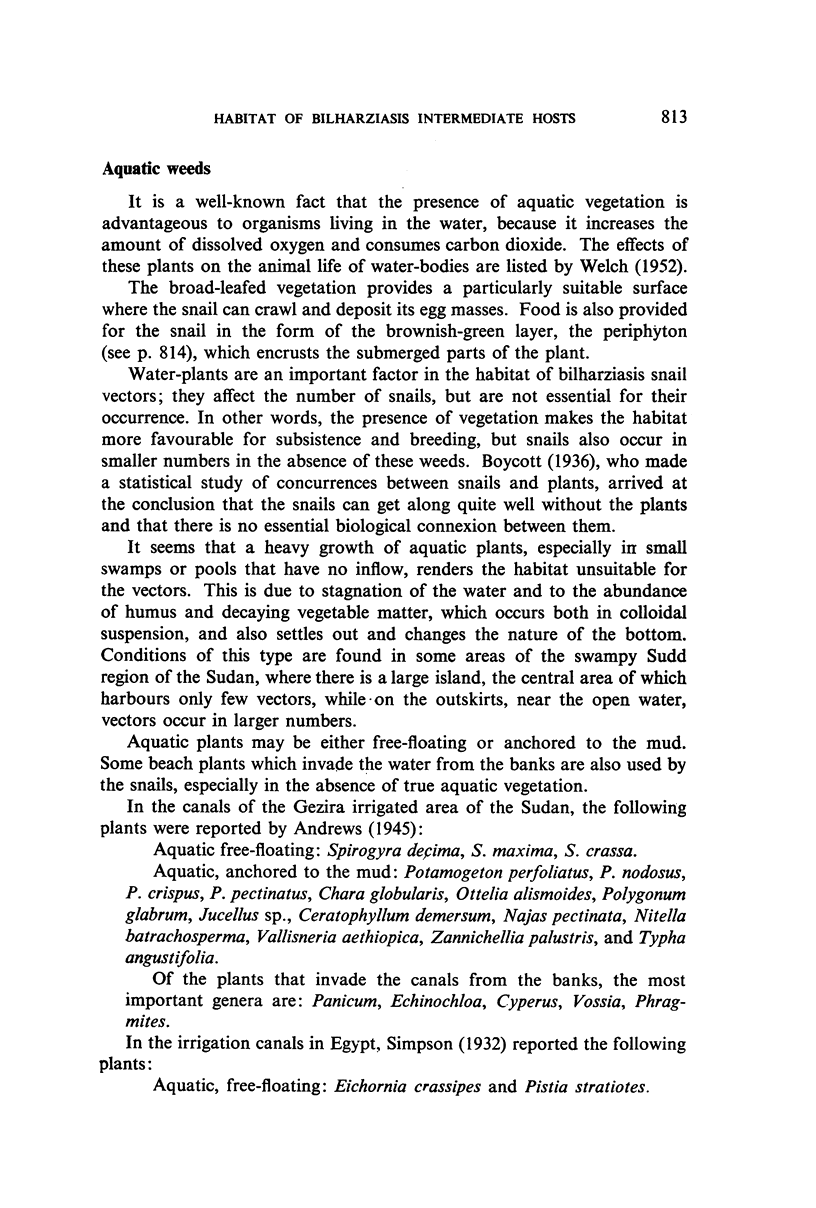
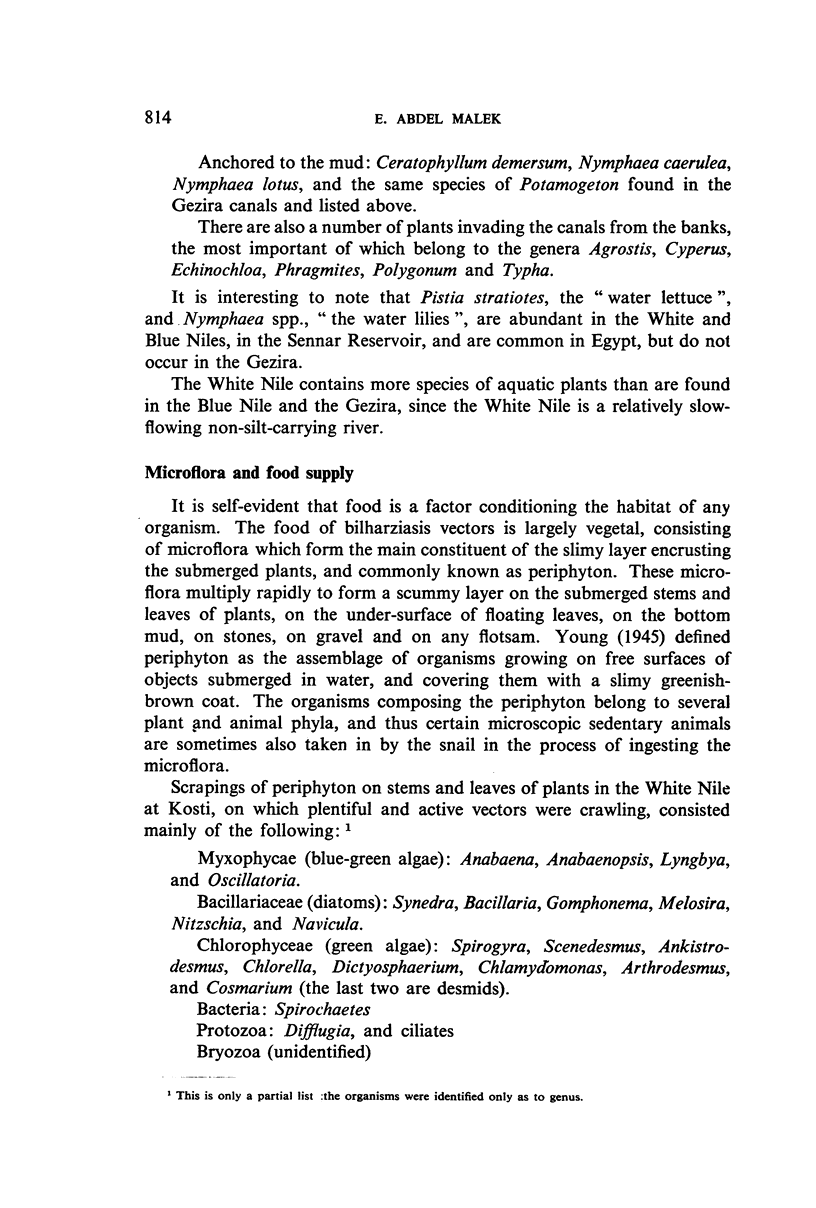
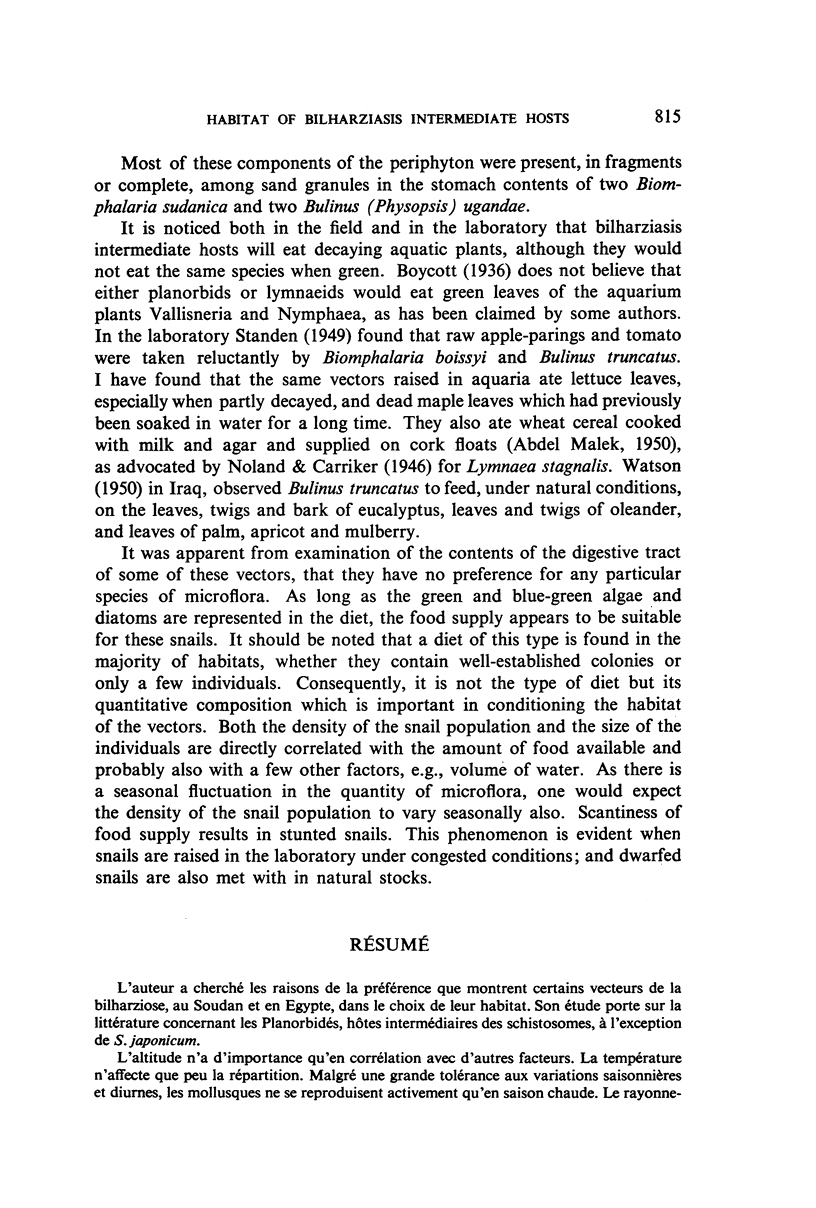
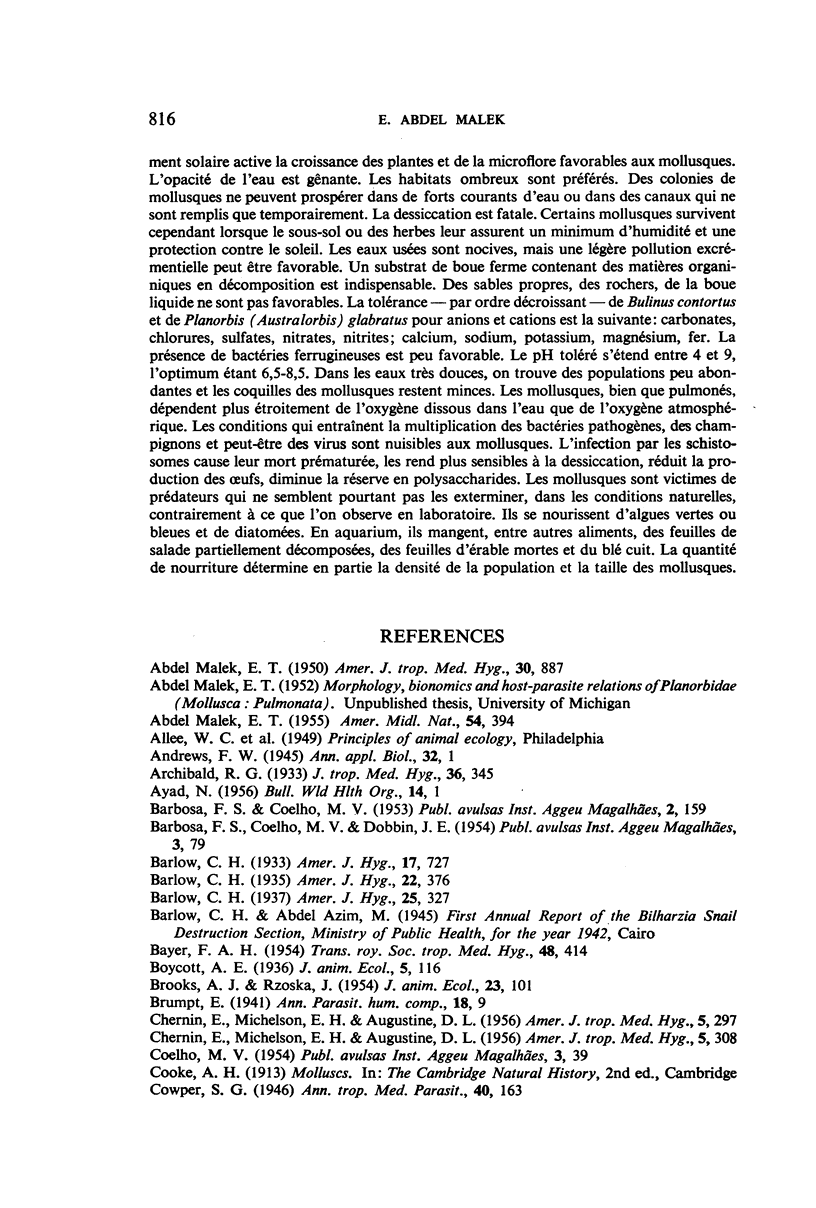
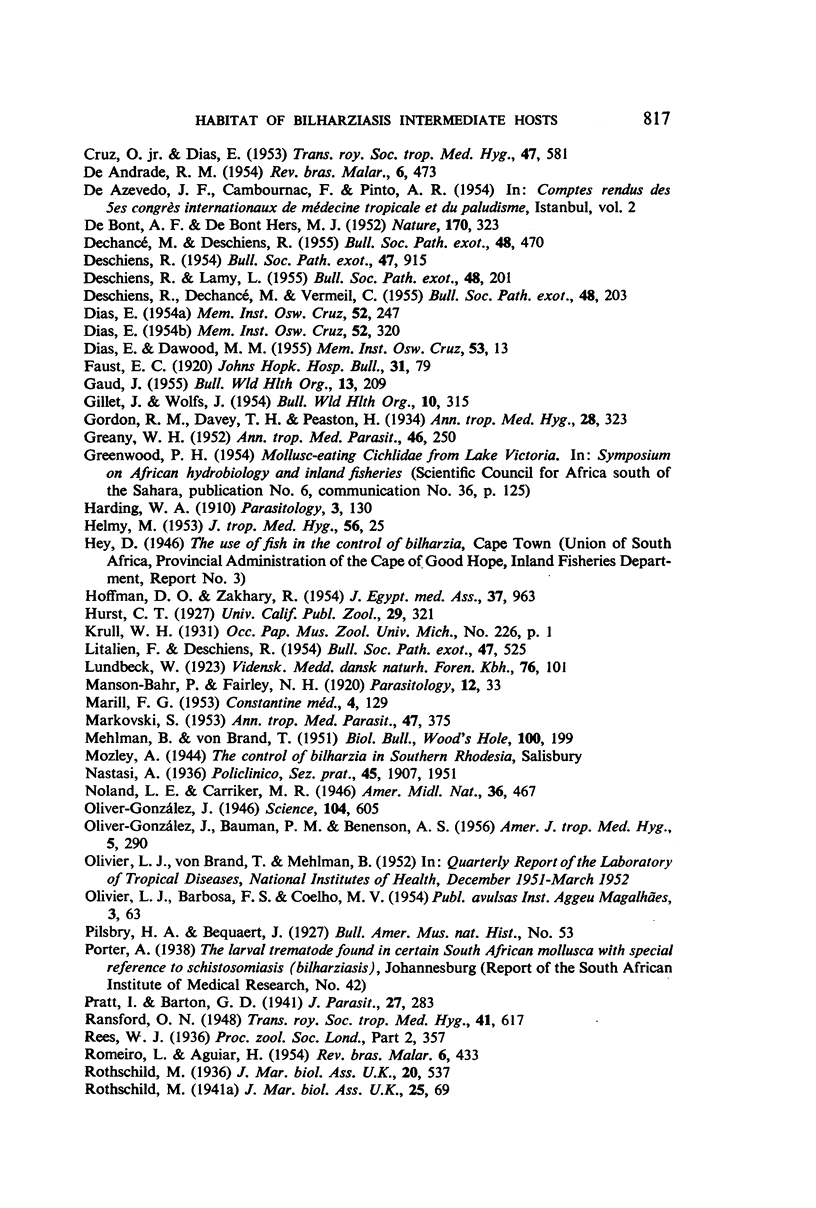
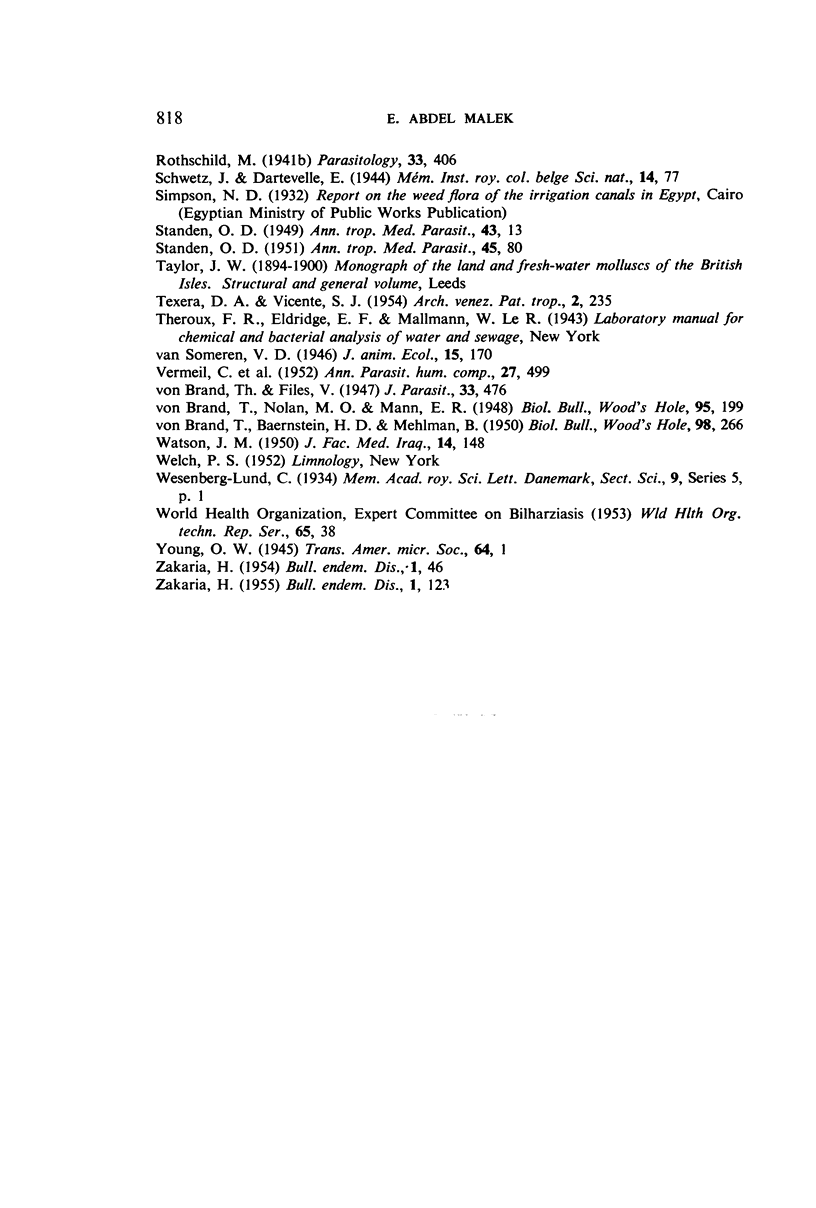
Selected References
These references are in PubMed. This may not be the complete list of references from this article.
- ABDEL-MALEK E. T. Susceptibility of the snail Biomphalaria boissyi to infection with certain strains of schistosoma mansoni. Am J Trop Med Hyg. 1950 Nov;30(6):887–894. doi: 10.4269/ajtmh.1950.s1-30.887. [DOI] [PubMed] [Google Scholar]
- BAYER F. A. Larval trematodes found in some fresh-water snails: a suggested biological method of bilharzia control. Trans R Soc Trop Med Hyg. 1954 Sep;48(5):414–418. doi: 10.1016/0035-9203(54)90142-x. [DOI] [PubMed] [Google Scholar]
- BRAND T. V., BAERNSTEIN H. D., MEHLMAN B. Studies on the anaerobic metabolism and the aerobic carbohydrate consumption of some fresh water snails. Biol Bull. 1950 Jun;98(3):266–276. doi: 10.2307/1538675. [DOI] [PubMed] [Google Scholar]
- CHERNIN E., MICHELSON E. H., AUGUSTINE D. L. Studies on the biological control of schistosome-bearing snails. I. The control of Australorbis glabratus populations by the snail, Marisa cornuarietis, under laboratory conditions. Am J Trop Med Hyg. 1956 Mar;5(2):297–307. [PubMed] [Google Scholar]
- CHERNIN E., MICHELSON E. H., AUGUSTINE D. L. Studies on the biological control of schistosome-bearing snails. II. The control of Australorbis glabratus populations by the leech, Helobdella fusca, under laboratory conditions. Am J Trop Med Hyg. 1956 Mar;5(2):308–314. [PubMed] [Google Scholar]
- CRUZ FILHO O., DIAS E. Bacillus pinottii sp. n. Trans R Soc Trop Med Hyg. 1953 Nov;47(6):581–582. doi: 10.1016/s0035-9203(53)80012-x. [DOI] [PubMed] [Google Scholar]
- DE ANDRADE R. M. Alguns dados hidroquímicos de criadouros de planorbídeos no Distrito Federal. Rev Bras Malariol Doencas Trop. 1954 Oct;6(4):473–475. [PubMed] [Google Scholar]
- DE BONT A. F., DE BONT HERS M. J. Mollusc control and fish-farming in Central Africa. Nature. 1952 Aug 23;170(4321):323–324. doi: 10.1038/170323a0. [DOI] [PubMed] [Google Scholar]
- DECHANCE M., DESCHIENS R. Action des sels de fer sur les mollusques vecteurs des bilharzioses. Bull Soc Pathol Exot Filiales. 1955;48(4):470–473. [PubMed] [Google Scholar]
- DESCHIENS R., DECHANCE M., VERMEIL C. Action prédatrice des crabes d'eau douce du genre Potamon sur les mollusques vecteurs des bilharzioses. Bull Soc Pathol Exot Filiales. 1955;48(2):203–207. [PubMed] [Google Scholar]
- DESCHIENS R. Incidence de la minéralisation de l'eau sur les mollusques vecteurs des bilharzioses; conséquences pratiques. Bull Soc Pathol Exot Filiales. 1954;47(6):915–929. [PubMed] [Google Scholar]
- DESCHIENS R., LAMY L. Préhension et ingestion des mollusques vecteurs des bilharzioses par les écrevisses du genre Cambarus. Bull Soc Pathol Exot Filiales. 1955;48(2):201–203. [PubMed] [Google Scholar]
- DIAS E., DAWOOD M. M. Preliminary trials on the biological snail control with Bacillus pinottii in Egypt. Mem Inst Oswaldo Cruz. 1955 May;53(1):13–29. doi: 10.1590/s0074-02761955000100002. [DOI] [PubMed] [Google Scholar]
- DIAS E. Guerra Bacteriológica contra os hospedeiros intermediários da esquistossomose humana. Mem Inst Oswaldo Cruz. 1954 Jun;52(2):315–320. doi: 10.1590/s0074-02761954000200003. [DOI] [PubMed] [Google Scholar]
- DIAS E. Nota prévia sôbre ensaios de combate aos planorbädeos por métodos biológicos e bioquämicos. Mem Inst Oswaldo Cruz. 1954 Mar;52(1):247–259. doi: 10.1590/s0074-02761954000100011. [DOI] [PubMed] [Google Scholar]
- GAUD J. Les bilharzioses en Afrique Occidentale et en Afrique Centrale. Bull World Health Organ. 1955;13(2):209–258. [PMC free article] [PubMed] [Google Scholar]
- GILLET J., WOLFS J. Les bilharzioses humaines au Congo Belge et au Ruanda-Urundi. Bull World Health Organ. 1954;10(3):315–419. [PMC free article] [PubMed] [Google Scholar]
- GREANY W. H. Schistosomiasis in the Gezira irrigated area of the Anglo-Egyption Sudan. I. Public health and field aspects. Ann Trop Med Parasitol. 1952 Nov;46(3):250–267. doi: 10.1080/00034983.1952.11685530. [DOI] [PubMed] [Google Scholar]
- HELMY M. The effect of environmental factors on the distribution and control of Planorbis boissyi, the intermediate host of Schistosoma mansoni in the Valley of the Nile. J Trop Med Hyg. 1953 Feb;56(2):25–32. [PubMed] [Google Scholar]
- HOFFMAN D. O., ZAKHARY R. A study of water temperatures in a representative Egyptian canal in connection with schistosomiasis control. J Egypt Med Assoc. 1954;37(8):963–967. [PubMed] [Google Scholar]
- LITALIEN F., DESCHIENS R. Comportement de mollusques vecteurs des bilharzioses en présence de nitrates et de nitrites alcalins. Bull Soc Pathol Exot Filiales. 1954;47(4):525–531. [PubMed] [Google Scholar]
- MARKOWSKI S. The distribution of the molluscan vectors of schistosomiasis in the Sennar area of the Sudan, and their invasion of the Gezira irrigation system. Ann Trop Med Parasitol. 1953 Dec;47(4):375–380. doi: 10.1080/00034983.1953.11685584. [DOI] [PubMed] [Google Scholar]
- MEHLMAN B., VON BRAND T. Further studies on the anaerobic metabolism of some fresh water snails. Biol Bull. 1951 Jun;100(3):199–205. doi: 10.2307/1538531. [DOI] [PubMed] [Google Scholar]
- OLIVER-GONZALES J., BAUMAN P. M., BENENSON A. S. Effect of the snail Marisa cornuarietis on Australorbis glabratus in natural bodies of water in Puerto Rico. Am J Trop Med Hyg. 1956 Mar;5(2):290–296. doi: 10.4269/ajtmh.1956.5.290. [DOI] [PubMed] [Google Scholar]
- Oliver-González J. The Possible Role of the Guppy, Lebistes reticulatus, on the Biological Control of Schistosomiasis mansoni. Science. 1946 Dec 20;104(2712):605–605. doi: 10.1126/science.104.2712.605-b. [DOI] [PubMed] [Google Scholar]
- ROMEIRO L., AGUIAR H. A influência do teor em cálcio do criadouro sôbre um planorrbídeo; nota prévia. Rev Bras Malariol Doencas Trop. 1954 Jul;6(3):433–439. [PubMed] [Google Scholar]
- STANDEN O. D. Experimental schistosomiasis; the culture of the snail vectors Planorbis boissyi and Bulinus truncatus. Ann Trop Med Parasitol. 1949 Apr;43(1):13–22. [PubMed] [Google Scholar]
- VERMEIL C., TOURNOUX P., TOCHEPORT G., NOGER C., SCHMITT P. Premières données sur l'état actuel des bilharzioses au Fezzan (lybie). Ann Parasitol Hum Comp. 1952;27(5):499–538. [PubMed] [Google Scholar]
- ZAKARIA H. Further study on the ecology of the intermediate host of Schistosoma haematobium, Bulinus truncatus Baylis. Bull Endem Dis (Baghdad) 1955 Jan;1(2):123–155. [PubMed] [Google Scholar]


